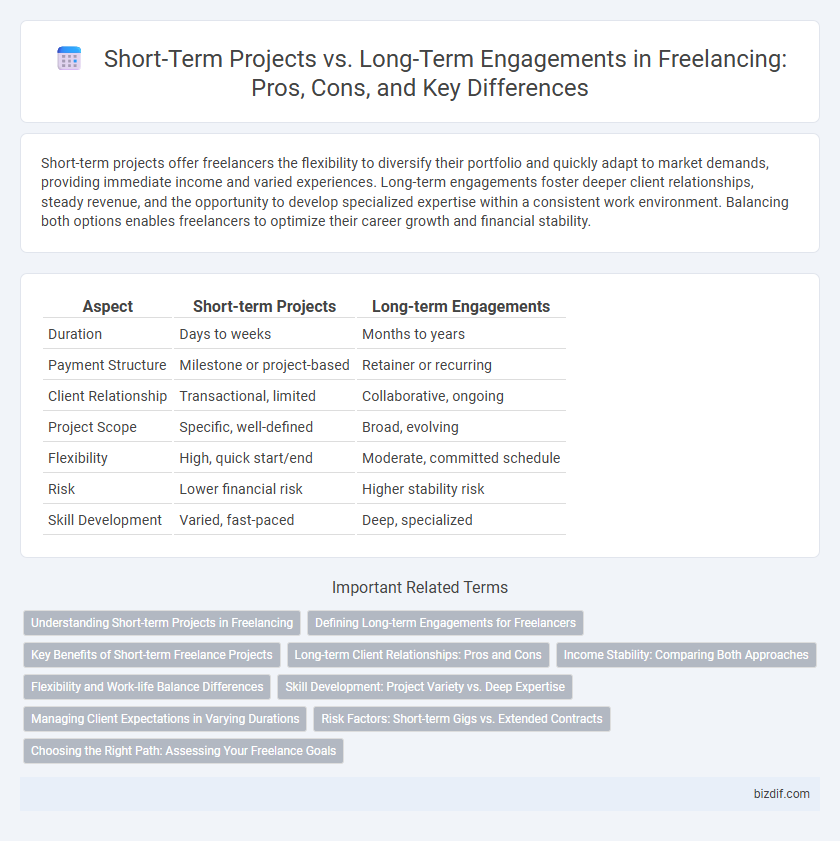Short-term projects offer freelancers the flexibility to diversify their portfolio and quickly adapt to market demands, providing immediate income and varied experiences. Long-term engagements foster deeper client relationships, steady revenue, and the opportunity to develop specialized expertise within a consistent work environment. Balancing both options enables freelancers to optimize their career growth and financial stability.
Table of Comparison
| Aspect | Short-term Projects | Long-term Engagements |
|---|---|---|
| Duration | Days to weeks | Months to years |
| Payment Structure | Milestone or project-based | Retainer or recurring |
| Client Relationship | Transactional, limited | Collaborative, ongoing |
| Project Scope | Specific, well-defined | Broad, evolving |
| Flexibility | High, quick start/end | Moderate, committed schedule |
| Risk | Lower financial risk | Higher stability risk |
| Skill Development | Varied, fast-paced | Deep, specialized |
Understanding Short-term Projects in Freelancing
Short-term projects in freelancing typically involve well-defined tasks with clear deadlines, allowing freelancers to quickly apply specific skills and deliver measurable results. These projects often provide flexibility and opportunities to diversify portfolios by working across multiple industries and clients in a condensed time frame. Mastering short-term projects helps freelancers build a strong reputation for reliability, adaptability, and efficient project completion.
Defining Long-term Engagements for Freelancers
Long-term engagements for freelancers typically involve ongoing contracts or retainer agreements that extend beyond a few months, providing steady income and consistent workload. These projects often require deeper collaboration, trust-building, and alignment with the client's business goals, leading to enhanced expertise and portfolio development. Freelancers benefit from predictable cash flow and professional growth opportunities through sustained partnerships with clients.
Key Benefits of Short-term Freelance Projects
Short-term freelance projects offer flexibility, allowing professionals to diversify their portfolio and gain varied industry experience quickly. They provide immediate income opportunities and enable freelancers to build robust client networks through multiple engagements. This project type reduces commitment risk, making it ideal for testing new skills or markets while maintaining a dynamic work schedule.
Long-term Client Relationships: Pros and Cons
Long-term client relationships in freelancing provide consistent income stability and deeper collaboration opportunities, fostering trust and improved project outcomes. However, they may limit exposure to diverse projects and reduce flexibility to pursue new clients or industries. Balancing long-term engagements with periodic skill updates ensures sustained growth and career resilience.
Income Stability: Comparing Both Approaches
Short-term projects offer freelancers quick income bursts but often lack consistent cash flow, leading to variable monthly earnings. Long-term engagements provide steady income streams that enhance financial stability and enable better budget planning. Balancing both approaches allows freelancers to optimize revenue while mitigating income fluctuations.
Flexibility and Work-life Balance Differences
Short-term projects offer freelancers increased flexibility, allowing them to choose diverse assignments and manage their schedules more freely, which enhances work-life balance. Long-term engagements provide steady income and deeper client relationships but may require more fixed hours and sustained commitment, potentially limiting personal time. Balancing these types of work helps freelancers optimize flexibility and maintain a healthy work-life integration.
Skill Development: Project Variety vs. Deep Expertise
Short-term projects expose freelancers to diverse tasks and industries, accelerating broad skill development and adaptability in dynamic markets. Long-term engagements enable deep expertise by allowing continuous improvement and mastery of specific tools or methodologies within a consistent domain. Balancing project variety with focused expertise enhances a freelancer's marketability and professional growth over time.
Managing Client Expectations in Varying Durations
Managing client expectations varies significantly between short-term projects and long-term engagements in freelancing. Clear communication about deliverables, timelines, and scope is essential in short-term projects to avoid misunderstandings and ensure swift completion. In long-term engagements, establishing regular progress updates and flexibility to adapt to evolving client needs supports sustained collaboration and trust.
Risk Factors: Short-term Gigs vs. Extended Contracts
Short-term projects pose higher income instability due to their limited duration and unpredictable client availability, increasing financial risk for freelancers. In contrast, long-term engagements offer consistent revenue streams and stronger client relationships but may limit flexibility and expose freelancers to dependency on fewer clients. Evaluating risk factors involves balancing immediate cash flow needs against the security and commitment level associated with extended contracts.
Choosing the Right Path: Assessing Your Freelance Goals
Short-term projects offer flexibility and diverse experience, ideal for freelancers seeking rapid skill expansion and varied portfolio development. Long-term engagements provide stability, consistent income, and deeper client relationships, benefiting those prioritizing reliable workflows and sustained growth. Assess freelance goals by weighing project duration preferences, income stability needs, and desired professional development outcomes.
Short-term Projects vs Long-term Engagements Infographic

 bizdif.com
bizdif.com